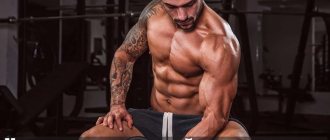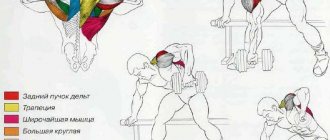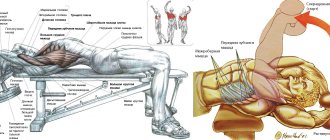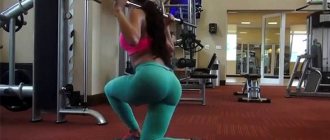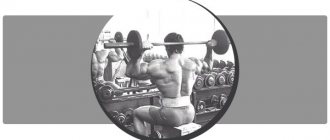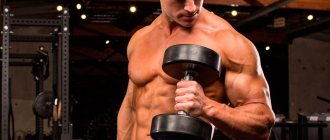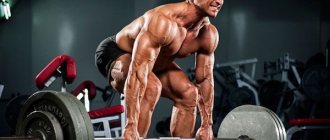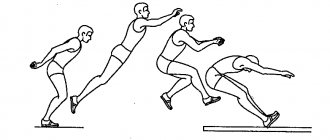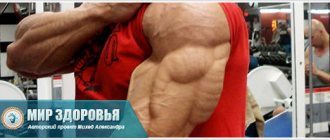Technique for performing incline dumbbell press:
- Adjust the back of the bench depending on the angle you choose. Press your feet to the floor. Lie down on the bench so that your body and head are pressed firmly against the surface. Take dumbbells. Raise your arms to the shoulder line. Palms should be facing up.
- Inhale and press the rounds upward. Exhale at the top of the exercise. Fix your position for a few seconds.
- Take a breath. Lower your arms to shoulder level. Then repeat the movement you have already mastered.
Number of repetitions: During strength training, the exercise should be performed 8 repetitions in 4 sets. And if your goal is muscle growth, then do 12 presses in 4 approaches.
Incline Dumbbell Press
The optimal angle of inclination of the stairs
To determine the optimal angle of inclination of a flight of stairs, they are guided by building regulations, technical features of the room and, of course, personal preferences.
It is believed that in private housing construction for everyday use the most acceptable slope is 45 degrees, optimal is 35-45 degrees, and ideal is 30-35. In these cases, when using the stairs, a person will make the least effort when moving and will not experience a feeling of discomfort.
However, it is not always rational to use precisely such slopes. Depending on the purpose and installation location, you should focus on other recommended values.
For example, by dividing all structures into several groups, you can determine the optimal angles of inclination:
- Ramps . Used when there are people with disabilities. They must be flat with angles of no more than 15 degrees.
- Street and garden stairs. Used in public spaces, parks, gardens. They should provide comfortable lifting for a wide range of people, so the inclination should not be significant - up to 30 degrees.
- Internal stairs. Used in apartment buildings and private buildings. It is believed that a staircase with a slope of 30 to 45 degrees is the most optimal, as it provides comfortable movement for the average person and does not occupy a large area.
- Attic stairs. In cases where it is impossible and/or impractical to install a classic staircase structure, steep but compact attic stairs with an angle of up to 60 degrees are used.
- Stepladders, ladders, fire escapes . Extension ladders are a temporary solution and are used extremely rarely; they are installed with a minimum slope, i.e. almost vertical.
Do not forget that the main criterion when choosing the angle of inclination of the stairs should be the needs of the people living in the house, since it is they who will have to use the structure to the greatest extent.
What muscles work
During the exercise, the main load falls on the muscles of the chest, especially the pectoralis major muscle. In addition, the movement involves the muscles of the abs, back, triceps and biceps. The deltoid muscles of the shoulders also work; the load on them depends on the value of the inclined angle.
Load on target muscles on a 10-point scale
| Chest - Upper | 8 (high) |
| Triceps | 5 (average) |
| Anterior delta | 5 (average) |
| Biceps | 1 (weak) |
| Abs and Forearms | 1 (weak) |
| Type of exercise | Power – Basic |
| Total load | 20 (average) |
Recommendations
- Pay attention to performing the exercise correctly. Don't try to increase the load. The weight of the dumbbells should be appropriate to your level of physical fitness.
- Control muscle tension. Avoid oscillating hand movements.
- Flatten your chest. Do not lift your shoulders and head off the bench. Watch the trajectory of your elbows to avoid injury.
- Breathe correctly. You will gain additional strength and endurance.
- At the top of the movement, maintain distance between sports equipment. Do not extend your arm completely to maintain the effectiveness of the exercise.
Basic mistakes
• Incorrect bench angle. An inclination angle of more than 60 degrees will shift the emphasis to the deltas. • Lifting of the pelvis and head from the bench, excessive arching of the back in the lumbar and thoracic regions. This position places the load on the shoulders rather than the chest. • The point of descent of the barbell is slightly higher than during a bench press. Throwing a projectile onto the collarbone can result in bone injuries. The correct point is found experimentally: at the lowest point you need to hold your forearms perpendicular to the floor surface. • Squeezing the barbell until your arms are straight. When the arms are fully straightened, the load is redistributed not to the pectoral muscles, but to the triceps brachii. Therefore, it is important to keep your elbows slightly bent. • The projectile should be lowered and squeezed out at an angle. Vertical movement places extra stress on the shoulder muscles, which increases the risk of injury. • When working with heavy weights, it is recommended to have a spotter. • Number of repetitions: 3 sets of 10-12 repetitions • Weight: The working weight is selected so as to repeat the bench press 10-12 times
Number of repetitions
: 3 sets of 10-12 repetitions
Weight
: The working weight is selected so as to repeat the bench press 10-12 times
Bent-over dumbbell press options
Exercise at a 30 degree angle
Dumbbell presses on a bench with an inclination angle of 30 degrees are done to work all the pectoral muscles. The muscles of the middle part of the sternum take on the greatest tension. The triceps are also tense. Use this angle if you do not need to focus on the upper part of the pectoral muscles.
Dumbbell press. Bench angle 30 degrees
On an incline bench at a 45 degree angle
As the angle of the bench back increases, the upper part of the sternum and deltoid muscles receive more tension. Additionally, the triceps work.
Dumbbell press. Bench angle 45 degrees
Bent over press at an angle of 60 degrees or higher
If you use a bench with an incline angle greater than 60 degrees, you will specifically engage the upper pecs and anterior deltoids. It is recommended to perform the exercise if you have a day of training the upper chest and anterior deltoids.
Dumbbell press. Bench angle 60 degrees
Dumbbell press. Bench angle 80 degrees
45 Degree Sight: Why do we need second sights?
In a number of combat situations, it may be necessary to quickly transfer fire from long distances to close ones, and vice versa. If you only have conventional iron sights, a simple red dot sight, or a holographic sight without magnification installed on your carbine, transferring shooting from long-range targets to near ones may not be so difficult. But if your optical sight is set to shoot at, say, 100 meters (and more often, much further), shooting with the same magnification at close distances is not so convenient, if not impossible. In this case, it would not be superfluous to install a 45-degree sight - an additional set of sighting devices located with an inclination of 45° to the right - for right-handers, and for left-handers, respectively, to the left.
The aiming technique is simple - turning the strong hand (holding the pistol grip of the carbine), accompanied by the movement of the elbow, changes the position of the carbine, rotating it around the longitudinal axis, and the sight appears at 45 degrees in front of the shooter's eye. In the version shown below, a collimator is used for long distances, and a mechanical, iron, rear sight with a front sight is used for short distances.
As we said above, it makes sense to install a sight at 45° when your weapon is already equipped with a high or variable magnification optical sight - then it will be convenient to quickly switch from long range to close range, and vice versa. However, the operator, at his own discretion, can install at least two pairs of mechanical sighting devices - as long as it is convenient and useful for him.
In addition, a good option as an additional sight would be to install a simple open collimator - this will not only simplify, but also increase the speed of aiming. On the other hand, if the batteries run out, you will be left without sights at all. Therefore, we consider the option of additional rear sight and front sight to be the most optimal.
How to set the scope at 45 degrees
The inclination of the sighting devices, of course, can be anything (there are options from 30° to 90°) - each has its own physiological characteristics and concepts of convenience. But the most justified, from a practical and functional point of view, is to install the sight at 45°. This position provides the best sighting picture without interfering with other elements on the weapon and allowing you to change the aiming line without problems.
There are three options for installing an additional sight - by purchasing an octagonal handguard with Picatinny rails and/or a KeyMod interface, or by mounting a special rail with the required tilt on a regular handguard (this method is used to install the collimator at 45 degrees). Or is it simply installing an inclined rear sight and front sight on the forend - the most economical and simplest method, since it does not require any intermediate links.
For example, mechanical sights, which are often called BIUS overseas, Back-Up Iron Sights, in the version from XS Sight Systems or from ATI, are placed at an angle, allowing you to place another sight in the line of sight by turning the weapon.
The advantage of them is that they only require a horizontal picatinny rail for placement, but not a special handguard for extra money.
You only have to buy the rear sight and front sight itself, and not the octagonal forend. Don't get me wrong, price is not the only issue here. Obviously, additional picatinny mounts often turn out to be superfluous, and at the same time they have considerable weight (even if they are aluminum). In order to optimize the weight of the weapon, it is much more logical to have one modular strap on top, used at 80%, than four straps, or eight, used at 15-25%.
And finally - as field tests have shown, in a shooting exercise where targets are located at 5-10, 50 and 100 meters, the use of an additional sight at 45 degrees (we used a collimator) improves the speed of the exercise by an average of 10-15%, and accuracy - by 20-30%. So it's worth it.
Bent-over dumbbell press: pros and cons
When performing the exercise, you will increase the amount of muscle mass. The incline dumbbell press is also valuable because the load is distributed evenly due to the incline of the bench. As a result, you will get a powerful and wide chest.
The disadvantage of the exercise is the lack of a gradual increase in load. Often, for athletes, such training becomes monotonous in feel, because they have to do it with approximately the same weight.
Features of the technique:
- If you want to increase the range of motion, then move the sports equipment to a level closer to the position of the bench. This way, working on the pectoral muscles will be as productive as possible.
- When you finish working with weights, slowly raise your body vertically, sit down on the bench and only then rise.
- Use heavy weight sports equipment only if there is a belayer present. Otherwise, do the exercise - machine chest press.
- Try curling dumbbells in front of your sternum if your fitness level allows.
- Stop doing the exercise if you experience a crunch in your elbow joints.
Safety regulations
- Don't make sudden movements. Raise your arms at the same time.
- Control the natural arch in your lower back. Tighten your abs. Fix the position of your feet on the floor. All this will help avoid unwanted consequences.
- After finishing the exercise, carefully straighten your arms and lower the dumbbells to the floor one by one.
Alternative options for performing the dumbbell bench press
One arm head up on an incline bench
This variation of the exercise is almost identical to the two-hand dumbbell press. The only drawback is that the athlete will begin to tire faster due to alternate work of the limbs. It is important to consider several nuances:
- Returning to the starting position should take twice as long as raising the arm to the top point.
- Avoid using excessively heavy dumbbell weights.
- To get into a sitting position, lift your feet off the floor by bending your knees. Place the apparatus on the upper thigh. Raise your body and push off the floor at the same time.
One-arm dumbbell incline press
Incline Dumbbell Press Head Down
This exercise allows you to shift the load from the top of the chest to the lower and middle fibers of the pectoral muscles. This allows you to symmetrically shape the appearance of the chest.
Incline Dumbbell Press Head Down
Notes
Athletes perform dumbbell presses both in fitness classes and in bodybuilding training. You can start your workout with this exercise. Doing it will help you make your muscles symmetrical and balanced in their work. It is recommended to continue the workout with dumbbell presses with downward slopes.
Lowering your legs
Lie on your back. You need to raise your legs up and then lower them until you can keep your lower back pressed to the floor. 10-20 repetitions.
Lowering legs one at a time
Now it’s a little different: one right leg lowers, then one left. 15-30 repetitions.
